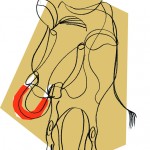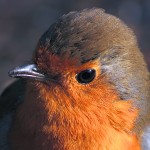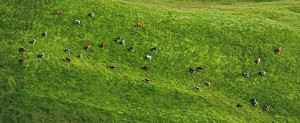SATURDAY, 7 MAY 2011
The ancient greeks, like many people since, were confounded and fascinated by the migration of birds. Homer recognised that cranes “flee the winter and the terrible rains and fly off to the world’s end”. Meanwhile, Aristotle wrongly asserted that each year summer redstarts would transform into robins come winter, as the two species were never seen in Greece together. In modern times, we have come to appreciate the vast distances covered by migratory animals and the remarkable precision with which they make the journey. How is this feat achieved?It is known that animals use sounds, landmarks or even smells to guide and navigate their way across continents. But the most intriguing and least understood navigation ability is magnetoreception: the detection of the Earth’s magnetic field through an internal, biological compass. Evidence for this capability was shown in a wide variety of animals, from ants to crocodiles. In fact, wildlife rangers in Florida resorted to taping magnets to the heads of crocodiles in order to prevent them finding their way back after being relocated. Magnetoreception has even been suggested in the humble cow, after researchers using Google Earth accidentally discovered that cows tend to line up parallel to the Earth’s magnetic field.
Magnetoreception was first observed in captive robins in 1957. In autumn, when it was time for them to migrate from Frankfurt to Spain, they kept flying southwest in their cage. This happened even though the room was isolated from any external visual stimuli with which the robins could orientate themselves. This led to the idea that robins might use an internal magnetic compass to migrate. Many studies have been conducted since, but controversy still rages over the exact underlying mechanism of magnetoreception.
Over fifty animal species have been found to use an internal magnetic compass so far, and several different mechanisms have been proposed and observed. The most established mechanism relies on the presence of small crystals of magnetite, a naturally magnetic mineral, in either the nose or the beak, surrounded by receptor nerves. Magnetite has been found in many animals, including humans, where it can be used to sense the magnetic field of the Earth and create a magnetic field map for migration. However, in experiments on birds where this magnetite receptor was deliberately disrupted by anaesthetic or a strong magnetic pulse, the birds could still orientate themselves along the magnetic field. This suggests that there is an alternative mechanism at work. Even more intriguingly, this alternative magnetoreception mechanism only works when there is visible light, and did not appear to be influenced by reversing the polarity of the field.
In 1978, Klaus Schulten suggested a mechanism for this type of magnetoreception, known as the radical pair mechanism. This mechanism proposes that there is a light-activated reaction in the bird’s eye that is affected by magnetism. By detecting the rate of the reaction, birds can sense the strength and direction of Earth’s magnetic field. The problem with this idea is that the Earth’s magnetic field is incredibly weak, and so its influence on a normal reaction is six orders of magnitude less than the energies involved in a normal chemical reaction. How could it possibly have a detectable effect?
The secret to detecting the magnetic field lies in generating a pair of radicals, which are molecules with unpaired electrons that interact strongly with magnetic fields. Creating these radicals requires a burst of energy, as provided when the molecules are exposed to light. Within a suitable molecule or protein, two radicals can form what is known as a ‘spin-correlated pair’ that exist in two different states. Conversion between these two states is affected by a magnetic field, and the rate of conversion can be monitored through the concentration of the radicals. In this way, a weak magnetic field can become detectable by cells in an organism.
The radical pair mechanism fits with the observations that cannot be reconciled with magnetite receptors. It is both dependent on the presence of light and unresponsive to the polarity of the field. Experimental evidence was lacking in 1978 when Schulten proposed the mechanism, so the idea received little attention for twenty years.
In 2000, a research group from Illinois suggested that proteins known as cryptochromes may be behind this source of magnetoreception. Cryptochrome proteins are found in the eye of robins, and absorb blue light to initiate a radical reaction—the perfect candidate to generate biologically detectable spin-correlated radical pairs. This led to renewed interest in the area, including the development of a proof-of-principle artificial magnetoreceptor system by a team of researchers at Oxford University. This was the first man-made chemical compass; the first artificial chemical system sufficiently sensitive to detect the Earth’s weak magnetic field on the planet’s surface.
The contribution of cryptochrome and the radical pair mechanism to magnetoreception in animals is still being investigated. Despite initial scepticism, evidence from model systems and computational work has shown that this mechanism is feasible for detecting magnetism. Cryptochromes are primarily responsible for maintaining circadian rhythms in many animals, including humans. Like many proteins throughout evolution, cryptochromes have found a new role in a different part of the body. From their presence in the eye, it has even been suggested that robins can sense the results of the radical reaction along the optic nerve, therefore the direction of the magnetic field may be visible to them in some sense.
With growing evidence of weak magnetic fields affecting biological processes, there is increasing interest in how they might affect us. Numerous studies have shown a significant correlation between proximity to high-voltage power lines—which carry a low frequency magnetic field—and increased rates of childhood leukaemia. In 2001 the International Agency for Research on Cancer classified extremely low frequency magnetic fields as a possible carcinogen. Yet several attempts to demonstrate magnetic field induced carcinogenesis or tumour promotion in cells have failed, so this issue is still surrounded by uncertainty.
Perhaps in years to come our suspicions of magnetic fields transforming healthy cells into cancerous ones might be viewed just as fanciful as Aristotle’s redstarts to robins hypothesis. While we cannot be sure yet that power lines cause cancer, further analysis of Google Earth has shown that they can certainly disrupt the ability of cows to line up with the Earth’s magnetic field—tricking them into aligning with the magnetic field of the power line instead.
Ian Le Guillou is a PhD student in the Department of Biochemistry




